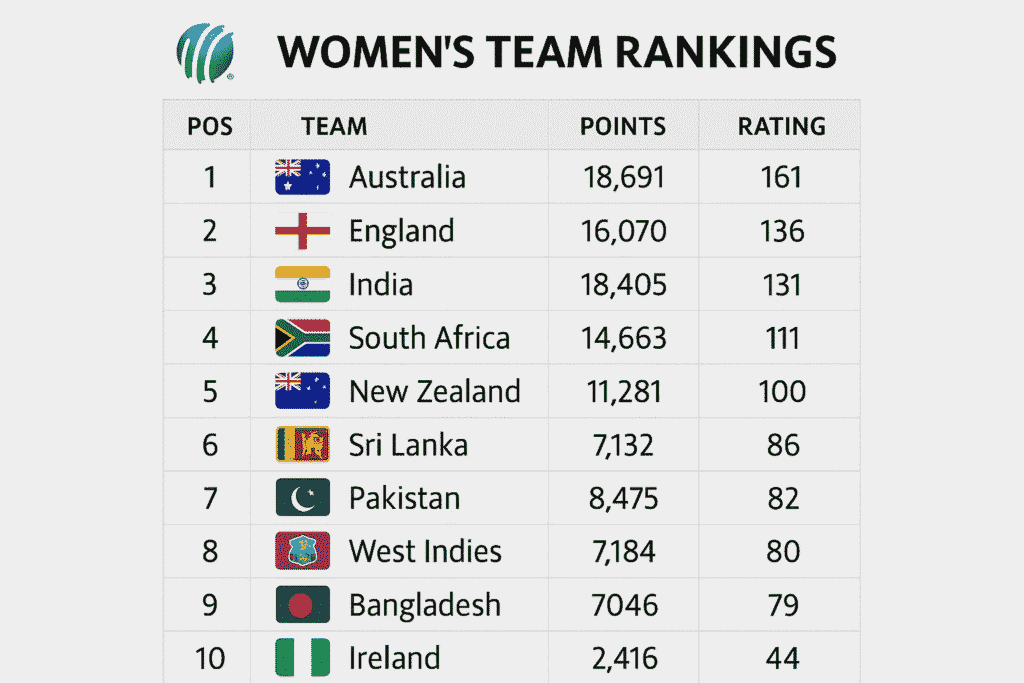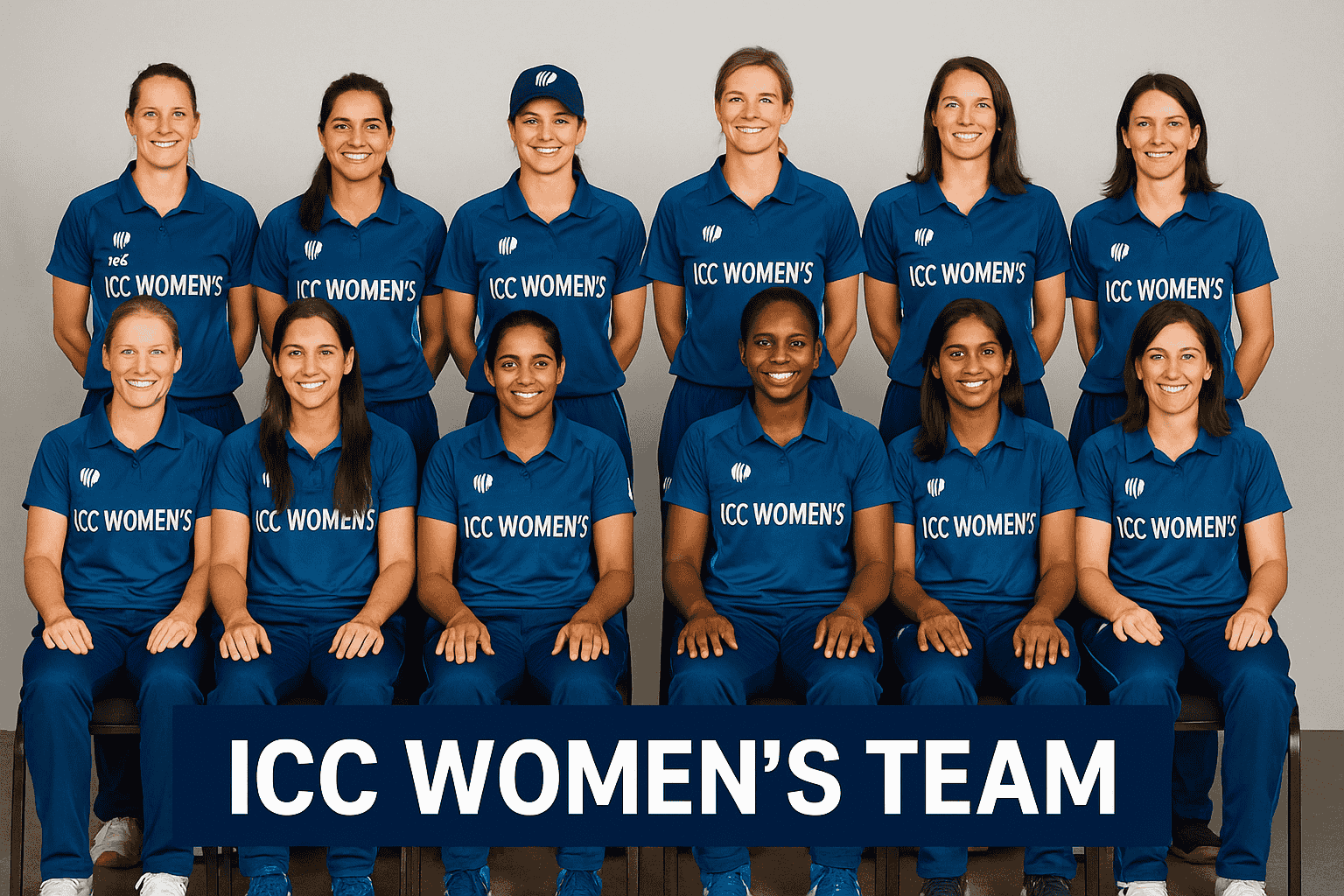Introduction To ICC Women’s Team Rankings
The cricket world buzzes with excitement as the ICC Women’s Team Rankings’ Latest Surprising Shifts continue to reshape the international women’s cricket landscape. Australia maintains its dominance across formats, with England and India remaining formidable contenders in the 2nd and 3rd positions, respectively. These recent developments showcase how dynamic and competitive women’s cricket has become, with teams constantly challenging established hierarchies through exceptional performances.
The ranking system reflects the evolving nature of women’s cricket, where traditional powerhouses face increasing pressure from emerging teams. Teams earn points through series victories, individual match performances, and consistent results across different formats. This comprehensive evaluation method ensures that the rankings accurately represent each team’s current form and capabilities.
Understanding the ICC Women’s Ranking System
The International Cricket Council employs a sophisticated points-based system to determine team rankings across all formats. The rating system involves dividing the points earned by the total from matches or series and rounding to the nearest whole number, akin to a batting average where points replace total runs. This methodology ensures fairness and accuracy in representing team performances.
Teams accumulate points through various factors, including match results, series outcomes, and the strength of opposition faced. Victory against higher-ranked opponents yields more points than defeating lower-ranked teams. This system rewards teams for challenging themselves against quality opposition while maintaining competitive balance.
The ranking updates occur regularly, reflecting recent performances and maintaining current relevance. Teams must consistently perform well to maintain their positions, as poor results can quickly impact their standings. This dynamic nature keeps the rankings fresh and encourages teams to maintain high standards throughout the year.
Current Standings Across Formats
ODI Rankings Transformation
The One-Day International format has witnessed significant movement in recent months. Traditional powerhouses find themselves challenged by emerging teams that demonstrate improved skills and strategic depth. Teams like New Zealand, South Africa, and the West Indies have shown remarkable progress, capitalizing on opportunities to upset established orders.
Australia continues to dominate the ODI rankings through consistent performances and strategic planning. Their comprehensive approach to team development, combined with experienced leadership, maintains their position at the summit. However, the gap between top teams has narrowed considerably, making every series crucial for maintaining rankings.
England’s position reflects its commitment to women’s cricket development and investment in infrastructure. Their domestic league structure provides players with regular competitive opportunities, translating into improved international performances. The team’s balanced approach across batting, bowling, and fielding departments supports their high ranking.
India’s rise in ODI rankings demonstrates the country’s growing focus on women’s cricket. Increased investment in training facilities, coaching staff, and player development programs has yielded impressive results. Their young talent pool, combined with experienced players, creates a formidable combination for future success.
T20I Rankings Revolution
The Twenty20 International format showcases the most dramatic shifts in recent rankings updates. The shorter format’s unpredictable nature allows teams to quickly improve their standings through focused improvements and tactical innovations. Teams that adapt quickly to changing conditions and opposition strategies gain significant advantages.
Australia’s dominance in T20I rankings stems from their aggressive approach and depth in talent. Their players excel in high-pressure situations, demonstrating mental strength and technical skills required for success in the shortest format. The team’s ability to perform consistently across different conditions strengthens their position.
England’s T20I ranking reflects their innovative approach to the format and willingness to experiment with different strategies. Their domestic T20 competition provides players with valuable experience in pressure situations. The team’s balanced squad composition allows for tactical flexibility during matches.
India’s improvement in T20I rankings showcases their adaptation to modern cricket demands. The emergence of young players with aggressive batting styles and innovative bowling techniques has enhanced their competitiveness. Their recent performances against top-ranked teams demonstrate growing confidence and skill levels.
Key Factors ICC Women’s Team Rankings Changes
Player Development Programs
Nations investing heavily in player development programs see significant improvements in their rankings. Comprehensive training facilities, qualified coaching staff, and regular competitive opportunities contribute to enhanced team performance. Countries that prioritize youth development often experience sustainable ranking improvements.
Modern training methods incorporate advanced analytics, fitness programs, and mental conditioning techniques. Teams utilizing these resources gain competitive advantages through improved preparation and performance optimization. The integration of technology in training programs helps players analyze their techniques and identify areas for improvement.
Infrastructure Investment
Strong domestic cricket infrastructure correlates directly with international ranking success. Countries with well-organized domestic leagues, quality playing facilities, and regular competitive tournaments develop stronger national teams. Investment in infrastructure creates pathways for talent identification and development.
Professional coaching at grassroots levels ensures proper technique development and strategic understanding. Teams with established coaching systems throughout their domestic structure produce more skilled players capable of competing at international levels. This systematic approach to development yields long-term ranking benefits.
Strategic Planning and Analytics
Modern cricket teams employ sophisticated analytical approaches to improve their rankings. Data-driven decision making helps teams identify opponent weaknesses, optimize team compositions, and develop effective strategies. Teams that embrace analytics often outperform those relying solely on traditional methods.
Video analysis, performance tracking, and opponent research provide valuable insights for strategic planning. Teams that invest in analytical capabilities gain competitive advantages through better preparation and tactical awareness. This scientific approach to cricket contributes significantly to ranking improvements.

Recent Surprising Movements
Emerging Teams Challenge Established Orders
Several teams have achieved remarkable ranking improvements through consistent performances and strategic developments. These movements highlight the increasingly competitive nature of women’s cricket and the narrowing gap between traditional powerhouses and emerging nations.
Teams like Bangladesh, Thailand, and Ireland have demonstrated significant improvements in their cricket standards. Their commitment to player development, coaching improvements, and competitive opportunities has translated into better international results. These achievements inspire other emerging nations to invest in their women’s cricket programs.
Veteran Teams Face New Challenges
Established cricket nations find themselves under pressure from improving opposition and internal transitions. Teams that previously dominated rankings must adapt to increased competition and maintain their standards to preserve their positions. This competitive environment benefits overall cricket quality.
The transition from experienced players to younger generations presents both opportunities and challenges. Teams managing this transition effectively maintain their rankings while building foundations for future success. Strategic planning during transitional periods determines long-term ranking sustainability.
Impact on Upcoming Tournaments
World Cup Implications
The upcoming ICC Women’s Cricket World Cup will significantly impact team rankings based on tournament performances. Teams performing well in the tournament will gain substantial ranking points, while poor performances can result in significant drops. The tournament’s high-stakes environment intensifies competition for ranking positions.
Tournament seeding based on current rankings affects team preparations and expectations. Higher-ranked teams face pressure to justify their positions, while lower-ranked teams view tournaments as opportunities for ranking advancement. This dynamic creates compelling competitive narratives throughout tournaments.
Future Series Significance
Bilateral series between highly-ranked teams carry increased significance for ranking implications. Teams must maintain consistent performance levels across all series to preserve their positions. The regular nature of bilateral cricket means that ranking positions constantly evolve based on recent results.
Home advantage becomes crucial for teams seeking ranking improvements. Teams that utilize familiar conditions effectively often achieve better results against visiting opposition. This factor adds strategic considerations to tour planning and team preparation.
Regional Development and Growth
Asian Cricket Expansion
The Asian region shows remarkable growth in women’s cricket development, with multiple teams improving their international standings. Countries like Thailand, Malaysia, and the UAE demonstrate a commitment to women’s cricket through increased investment and competitive opportunities.
India’s success inspires other Asian nations to prioritize women’s cricket development. The sharing of expertise, coaching resources, and competitive opportunities within the region benefits overall cricket standards. This collaborative approach accelerates development across multiple nations.
European Cricket Renaissance
European nations demonstrate renewed focus on women’s cricket development, with several teams achieving ranking improvements. Countries like the Netherlands, Scotland, and Germany invest in infrastructure and coaching to enhance their international competitiveness.
The European Cricket Council’s initiatives support women’s cricket development through structured competitions and development programs. These efforts create pathways for talented players to develop their skills and represent their countries at international levels.
Technology and Modern Cricket
Performance Analysis Revolution
Advanced technology transforms how teams analyze performances and develop strategies. Video analysis systems, performance tracking devices, and data analytics provide unprecedented insights into player and team performances. Teams embracing these technologies gain competitive advantages in preparation and execution.
Real-time performance monitoring during matches allows coaches to make informed tactical decisions. This immediate feedback helps teams adapt their strategies based on current match situations and opponent responses. The integration of technology enhances decision-making capabilities throughout matches.
Training Innovation
Modern training methods incorporate virtual reality, biomechanical analysis, and customized fitness programs. These innovations help players develop specific skills and maintain peak physical condition. Teams utilizing advanced training methods often demonstrate superior performance consistency.
Injury prevention programs using modern technology reduce player unavailability and maintain team strength. Sports science applications help teams optimize player workloads and recovery processes. This comprehensive approach to player management contributes to sustained ranking success.
Future Outlook and Predictions
Ranking Volatility Expectations
The increasing competitiveness of women’s cricket suggests continued ranking volatility in the coming years. Teams must maintain consistent high standards to preserve their positions as opposition quality improves globally. This environment creates exciting possibilities for ranking changes.
Investment in women’s cricket continues to grow worldwide, promising enhanced competition levels. Countries recognizing the value of women’s cricket success allocate resources to development programs. This trend suggests that ranking surprises will become increasingly common.
Development Program Impact
Long-term development programs implemented by various nations will yield results in future ranking cycles. Countries investing in youth development and infrastructure today will see benefits reflected in their international rankings. This strategic approach ensures sustainable cricket growth.
The success of current development initiatives encourages other nations to implement similar programs. The sharing of best practices and successful strategies accelerates global women’s cricket development. This collaborative approach benefits the entire cricket community.
Conclusion
The ICC Women’s Team Rankings: Latest Surprising Shifts reflect the dynamic and evolving nature of international women’s cricket. Teams across all formats demonstrate increasing competitiveness, with traditional hierarchies facing constant challenges from emerging nations. The sophisticated ranking system accurately captures these developments while providing fair representation of current team capabilities.
Investment in player development, infrastructure, and strategic planning drives ranking improvements across multiple nations. Teams that embrace modern training methods, analytical approaches, and comprehensive development programs achieve sustainable ranking success. The future promises continued excitement as women’s cricket maintains its upward trajectory.
The competitive landscape will continue evolving as more nations invest in women’s cricket development. These trends suggest that ranking surprises will become increasingly common, creating compelling narratives for cricket fans worldwide. The growth of women’s cricket benefits from this increased competitiveness and global development focus.



